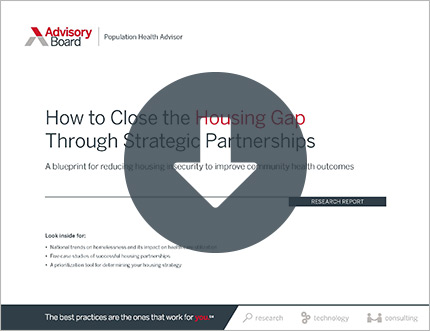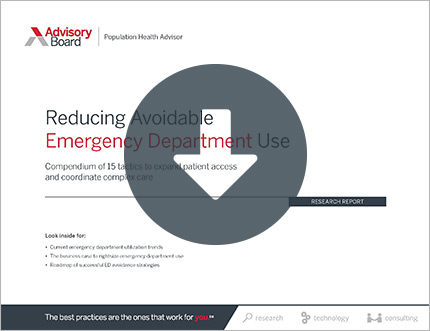Lehigh Valley Health Network (LVHN), Vanderbilt University Medical Center, and other hospitals are establishing "street medicine" programs to provide basic health care and social services to the homeless—and some are generating unexpected savings in the process.
From healthy food access to stable housing: The case for collaboration with community partners
Background
According to a recent estimate from the Department of Housing and Urban Development, around 550,000 people were homeless on any given night in 2016, and around a third of them were sleeping outside, in an abandoned house, or some other "unsheltered" place.
To better provide care for the homeless, advocates in the 1980s and 1990s pioneered street medicine programs, initiatives in which providers meet homeless and other disadvantaged individuals where they are to provide primary care and social services, the Post reports. Over the past five years, the movement has grown substantially, increasing from about a dozen programs to more than 60 across the country, the Post reports.
How LVHN operates its street medicine program—and saved nearly $4M
LVHN operates one such program, helmed by physician assistant Brett Feldman, that includes a street medicine team, medical facilities at eight shelters and soup kitchens throughout the Lehigh Valley area, and a hospital consultation program.
Feldman and his team spend most of their time providing primary care services—such as treatment for cuts, sprains, and chronic conditions—to homeless people throughout the Lehigh Valley area. But the team goes a step further: They also help people sign up for Medicaid, apply for Social Security disability benefits, or find a home. And frequently, the team provides or arranges mental health services, ranging from conversations with patients or to providing suicide prevention care.
According to the Post, the street medicine program treats an estimated 1,500 patients per year. Since 2015, among participants, the program has boosted insurance coverage—primarily Medicaid—to 74%; cut ED visits by about 75%; and slashed ED admissions by about 66%. All told, the reduced ED visits and admissions resulted in a $3.7 million increase to LVHN's bottom line in fiscal year 2017.
Vanderbilt's focus on mental health care
Meanwhile, another street medicine program—helmed by Sheryl Fleisch, a psychiatrist at Vanderbilt University Medical Center—aims to tackle "perhaps the biggest issue facing street medicine": how to provide mental health care services, the Post reports.
According to the Post, about one-third of homeless people have severe mental illnesses, and two-thirds have substance use disorders. In turn, given the frequently long delays in arranging psychiatric evaluations, patients may not be able to promptly access needed medication or may miss chances to get housing.
To address the issue, Fleisch and her team every Wednesday distribute basic necessities, such as clothing and blankets, to homeless people at camps in Nashville, Tennessee, before splitting up to meet one-on-one with individuals. During these meetings, if needed, providers distribute a week's worth of medication to patients. And according to Fleisch, these patients—many of whom "have been thrown out of other programs or are too anxious to go to regular office sessions"—rarely miss appointments.
Challenges facing street medicine programs
In addition to providing mental health care, street medicine programs face other challenges, such as procuring funding and garnering greater recognition. For instance, citing the unique challenges of treating the homeless and disadvantaged population, proponents of street medicine contend the services should be considered a medical subspecialty.
Ultimately, however, Feldman said he believes the most important aspect of these programs is providing patients with a sense of hope. "Most of our folks think they will die alone, that their future is canceled," he said. "Bringing hope is more important than any medicine" (Gooch, Becker's Hospital Review, 11/28; McGinley, Washington Post, 11/22).
From healthy food access to stable housing: The case for collaboration with community partners
Population health leaders know that health care delivery is incomplete without addressing the social determinants of health. But effective patient management cannot only include tasking care teams with addressing patients' social needs on top of their complex clinical needs.
Instead, providers should also partner with community-based organizations already providing quality non-clinical support for a range of needs, from healthy food access to stable housing, to scale patient management beyond traditional care settings.
Don't miss out on the latest Advisory Board insights
Create your free account to access 2 resources each month, including the latest research and webinars.
Want access without creating an account?
You have 2 free members-only resources remaining this month remaining this month.
1 free members-only resources remaining this month
1 free members-only resources remaining this month
You've reached your limit of free monthly insights
Become a member to access all of Advisory Board's resources, events, and experts
Never miss out on the latest innovative health care content tailored to you.
Benefits include:
You've reached your limit of free monthly insights



